Wenpeng Lu
A Survey on Training-free Alignment of Large Language Models
Aug 12, 2025Abstract:The alignment of large language models (LLMs) aims to ensure their outputs adhere to human values, ethical standards, and legal norms. Traditional alignment methods often rely on resource-intensive fine-tuning (FT), which may suffer from knowledge degradation and face challenges in scenarios where the model accessibility or computational resources are constrained. In contrast, training-free (TF) alignment techniques--leveraging in-context learning, decoding-time adjustments, and post-generation corrections--offer a promising alternative by enabling alignment without heavily retraining LLMs, making them adaptable to both open-source and closed-source environments. This paper presents the first systematic review of TF alignment methods, categorizing them by stages of pre-decoding, in-decoding, and post-decoding. For each stage, we provide a detailed examination from the viewpoint of LLMs and multimodal LLMs (MLLMs), highlighting their mechanisms and limitations. Furthermore, we identify key challenges and future directions, paving the way for more inclusive and effective TF alignment techniques. By synthesizing and organizing the rapidly growing body of research, this survey offers a guidance for practitioners and advances the development of safer and more reliable LLMs.
CCHall: A Novel Benchmark for Joint Cross-Lingual and Cross-Modal Hallucinations Detection in Large Language Models
May 25, 2025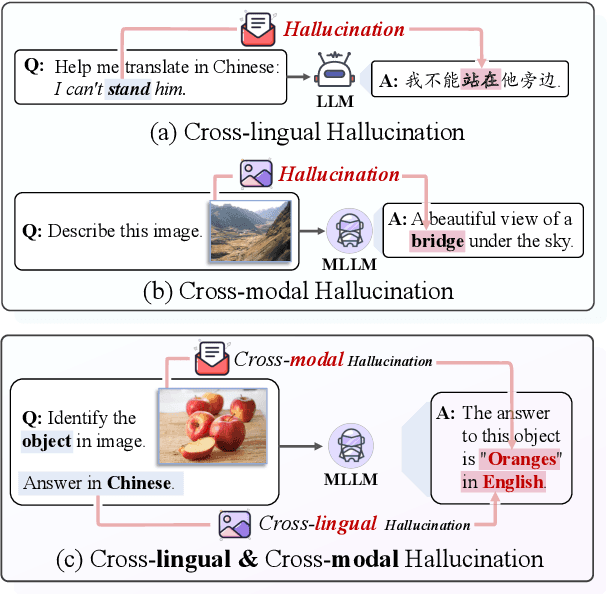



Abstract:Investigating hallucination issues in large language models (LLMs) within cross-lingual and cross-modal scenarios can greatly advance the large-scale deployment in real-world applications. Nevertheless, the current studies are limited to a single scenario, either cross-lingual or cross-modal, leaving a gap in the exploration of hallucinations in the joint cross-lingual and cross-modal scenarios. Motivated by this, we introduce a novel joint Cross-lingual and Cross-modal Hallucinations benchmark (CCHall) to fill this gap. Specifically, CCHall simultaneously incorporates both cross-lingual and cross-modal hallucination scenarios, which can be used to assess the cross-lingual and cross-modal capabilities of LLMs. Furthermore, we conduct a comprehensive evaluation on CCHall, exploring both mainstream open-source and closed-source LLMs. The experimental results highlight that current LLMs still struggle with CCHall. We hope CCHall can serve as a valuable resource to assess LLMs in joint cross-lingual and cross-modal scenarios.
SRLCG: Self-Rectified Large-Scale Code Generation with Multidimensional Chain-of-Thought and Dynamic Backtracking
Apr 01, 2025Abstract:Large language models (LLMs) have revolutionized code generation, significantly enhancing developer productivity. However, for a vast number of users with minimal coding knowledge, LLMs provide little support, as they primarily generate isolated code snippets rather than complete, large-scale project code. Without coding expertise, these users struggle to interpret, modify, and iteratively refine the outputs of LLMs, making it impossible to assemble a complete project. To address this issue, we propose Self-Rectified Large-Scale Code Generator (SRLCG), a framework that generates complete multi-file project code from a single prompt. SRLCG employs a novel multidimensional chain-of-thought (CoT) and self-rectification to guide LLMs in generating correct and robust code files, then integrates them into a complete and coherent project using our proposed dynamic backtracking algorithm. Experimental results show that SRLCG generates code 15x longer than DeepSeek-V3, 16x longer than GPT-4, and at least 10x longer than other leading CoT-based baselines. Furthermore, they confirm its improved correctness, robustness, and performance compared to baselines in large-scale code generation.
BianCang: A Traditional Chinese Medicine Large Language Model
Nov 17, 2024



Abstract:The rise of large language models (LLMs) has driven significant progress in medical applications, including traditional Chinese medicine (TCM). However, current medical LLMs struggle with TCM diagnosis and syndrome differentiation due to substantial differences between TCM and modern medical theory, and the scarcity of specialized, high-quality corpora. This paper addresses these challenges by proposing BianCang, a TCM-specific LLM, using a two-stage training process that first injects domain-specific knowledge and then aligns it through targeted stimulation. To enhance diagnostic and differentiation capabilities, we constructed pre-training corpora, instruction-aligned datasets based on real hospital records, and the ChP-TCM dataset derived from the Pharmacopoeia of the People's Republic of China. We compiled extensive TCM and medical corpora for continuous pre-training and supervised fine-tuning, building a comprehensive dataset to refine the model's understanding of TCM. Evaluations across 11 test sets involving 29 models and 4 tasks demonstrate the effectiveness of BianCang, offering valuable insights for future research. Code, datasets, and models are available at https://github.com/QLU-NLP/BianCang.
PMoL: Parameter Efficient MoE for Preference Mixing of LLM Alignment
Nov 02, 2024Abstract:Reinforcement Learning from Human Feedback (RLHF) has been proven to be an effective method for preference alignment of large language models (LLMs) and is widely used in the post-training process of LLMs. However, RLHF struggles with handling multiple competing preferences. This leads to a decrease in the alignment of LLMs with human preferences. To address this issue, we propose Preference Mixture of LoRAs (PMoL) from the perspective of model architecture, which can adapt to any number of preferences to mix. PMoL combines Mixture of Experts (MoE) and Low Rank Adaptor (LoRA). This architecture is innovatively applied to the research of preference alignment and has achieved significant performance improvement. The expert group soft loss is used to enable MoE with the ability to mix preferences. Through comprehensive evaluation by the reward model and GPT-4o, the experiment results show that PMoL has superior preference mixing capabilities compared to baseline methods. PMoL achieves better preference alignment with lower training costs.
Wrong-of-Thought: An Integrated Reasoning Framework with Multi-Perspective Verification and Wrong Information
Oct 06, 2024



Abstract:Chain-of-Thought (CoT) has become a vital technique for enhancing the performance of Large Language Models (LLMs), attracting increasing attention from researchers. One stream of approaches focuses on the iterative enhancement of LLMs by continuously verifying and refining their reasoning outputs for desired quality. Despite its impressive results, this paradigm faces two critical issues: (1) Simple verification methods: The current paradigm relies solely on a single verification method. (2) Wrong Information Ignorance: Traditional paradigms directly ignore wrong information during reasoning and refine the logic paths from scratch each time. To address these challenges, we propose Wrong-of-Thought (WoT), which includes two core modules: (1) Multi-Perspective Verification: A multi-perspective verification method for accurately refining the reasoning process and result, and (2) Wrong Information Utilization: Utilizing wrong information to alert LLMs and reduce the probability of LLMs making same mistakes. Experiments on 8 popular datasets and 5 LLMs demonstrate that WoT surpasses all previous baselines. In addition, WoT exhibits powerful capabilities in difficult computation tasks.
CHECKWHY: Causal Fact Verification via Argument Structure
Aug 20, 2024Abstract:With the growing complexity of fact verification tasks, the concern with "thoughtful" reasoning capabilities is increasing. However, recent fact verification benchmarks mainly focus on checking a narrow scope of semantic factoids within claims and lack an explicit logical reasoning process. In this paper, we introduce CheckWhy, a challenging dataset tailored to a novel causal fact verification task: checking the truthfulness of the causal relation within claims through rigorous reasoning steps. CheckWhy consists of over 19K "why" claim-evidence-argument structure triplets with supports, refutes, and not enough info labels. Each argument structure is composed of connected evidence, representing the reasoning process that begins with foundational evidence and progresses toward claim establishment. Through extensive experiments on state-of-the-art models, we validate the importance of incorporating the argument structure for causal fact verification. Moreover, the automated and human evaluation of argument structure generation reveals the difficulty in producing satisfying argument structure by fine-tuned models or Chain-of-Thought prompted LLMs, leaving considerable room for future improvements.
CroPrompt: Cross-task Interactive Prompting for Zero-shot Spoken Language Understanding
Jun 15, 2024Abstract:Slot filling and intent detection are two highly correlated tasks in spoken language understanding (SLU). Recent SLU research attempts to explore zero-shot prompting techniques in large language models to alleviate the data scarcity problem. Nevertheless, the existing prompting work ignores the cross-task interaction information for SLU, which leads to sub-optimal performance. To solve this problem, we present the pioneering work of Cross-task Interactive Prompting (CroPrompt) for SLU, which enables the model to interactively leverage the information exchange across the correlated tasks in SLU. Additionally, we further introduce a multi-task self-consistency mechanism to mitigate the error propagation caused by the intent information injection. We conduct extensive experiments on the standard SLU benchmark and the results reveal that CroPrompt consistently outperforms the existing prompting approaches. In addition, the multi-task self-consistency mechanism can effectively ease the error propagation issue, thereby enhancing the performance. We hope this work can inspire more research on cross-task prompting for SLU.
An empirical study of next-basket recommendations
Dec 05, 2023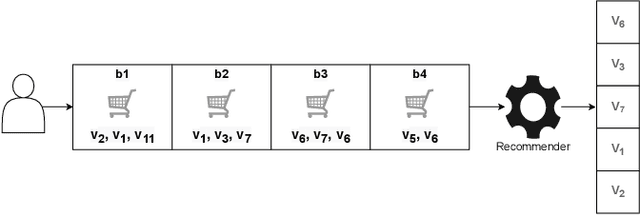
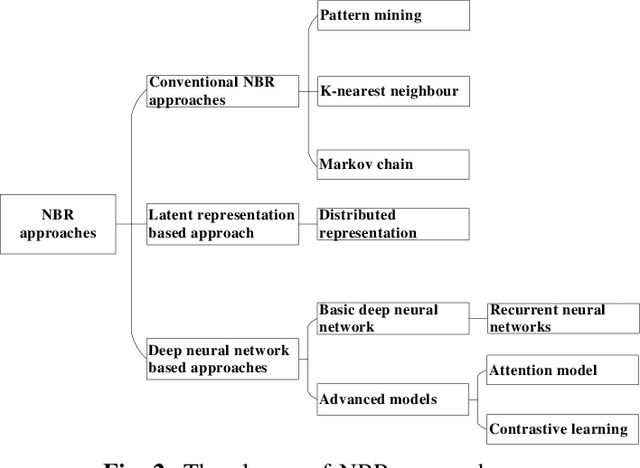
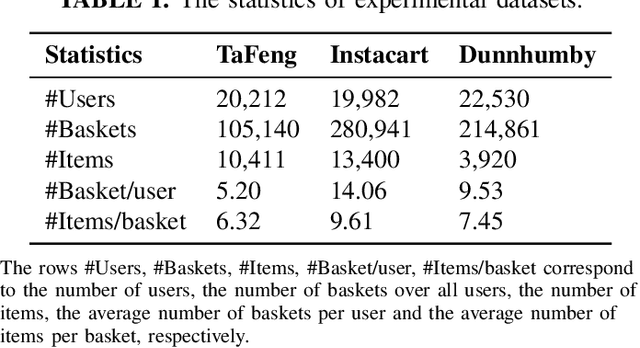
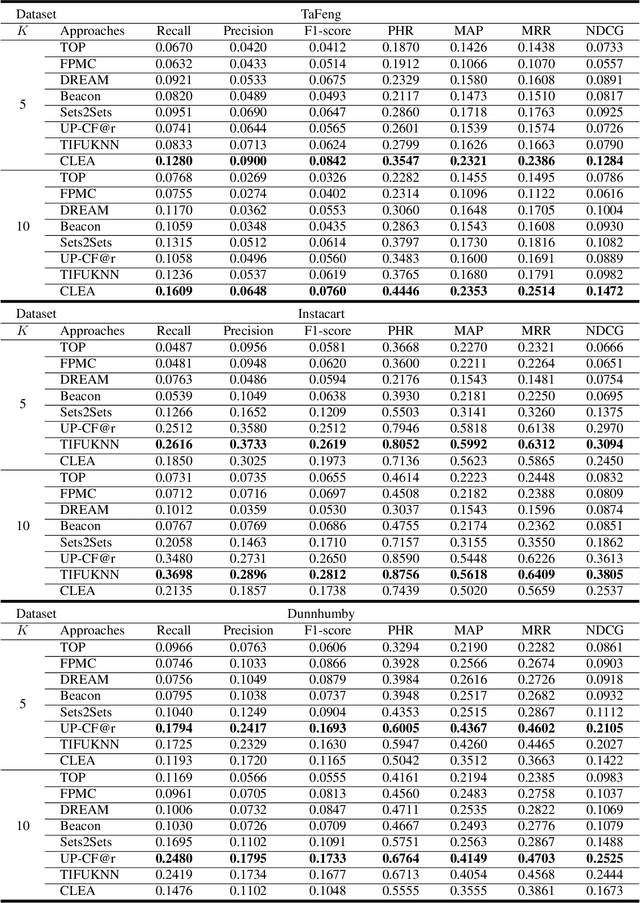
Abstract:Next Basket Recommender Systems (NBRs) function to recommend the subsequent shopping baskets for users through the modeling of their preferences derived from purchase history, typically manifested as a sequence of historical baskets. Given their widespread applicability in the E-commerce industry, investigations into NBRs have garnered increased attention in recent years. Despite the proliferation of diverse NBR methodologies, a substantial challenge lies in the absence of a systematic and unified evaluation framework across these methodologies. Various studies frequently appraise NBR approaches using disparate datasets and diverse experimental settings, impeding a fair and effective comparative assessment of methodological performance. To bridge this gap, this study undertakes a systematic empirical inquiry into NBRs, reviewing seminal works within the domain and scrutinizing their respective merits and drawbacks. Subsequently, we implement designated NBR algorithms on uniform datasets, employing consistent experimental configurations, and assess their performances via identical metrics. This methodological rigor establishes a cohesive framework for the impartial evaluation of diverse NBR approaches. It is anticipated that this study will furnish a robust foundation and serve as a pivotal reference for forthcoming research endeavors in this dynamic field.
Knowledge-Aware Prompt Tuning for Generalizable Vision-Language Models
Aug 22, 2023



Abstract:Pre-trained vision-language models, e.g., CLIP, working with manually designed prompts have demonstrated great capacity of transfer learning. Recently, learnable prompts achieve state-of-the-art performance, which however are prone to overfit to seen classes, failing to generalize to unseen classes. In this paper, we propose a Knowledge-Aware Prompt Tuning (KAPT) framework for vision-language models. Our approach takes inspiration from human intelligence in which external knowledge is usually incorporated into recognizing novel categories of objects. Specifically, we design two complementary types of knowledge-aware prompts for the text encoder to leverage the distinctive characteristics of category-related external knowledge. The discrete prompt extracts the key information from descriptions of an object category, and the learned continuous prompt captures overall contexts. We further design an adaptation head for the visual encoder to aggregate salient attentive visual cues, which establishes discriminative and task-aware visual representations. We conduct extensive experiments on 11 widely-used benchmark datasets and the results verify the effectiveness in few-shot image classification, especially in generalizing to unseen categories. Compared with the state-of-the-art CoCoOp method, KAPT exhibits favorable performance and achieves an absolute gain of 3.22% on new classes and 2.57% in terms of harmonic mean.
 Add to Chrome
Add to Chrome Add to Firefox
Add to Firefox Add to Edge
Add to Edge